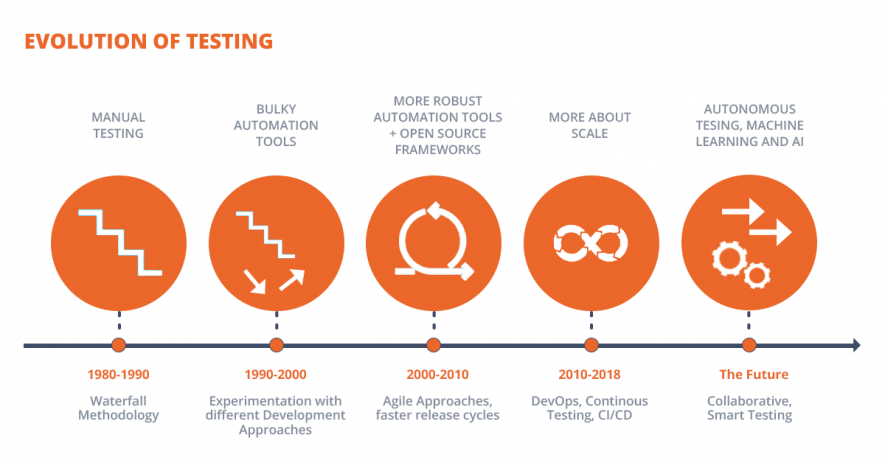The Evolution of Software Testing: From Manual to Automated

I.Introduction to the Evolution of Software Testing
In recent years, software testing has undergone a significant transformation, where it has transcended the processes conducted manually to sophisticated forms of testing innovation and automated testing devices. As software products become more complex and the demand for faster, more efficient development cycles grows, the software testing landscape has evolved significantly.
As software applications became more complex and interdependent, traditional manual testing methods became inadequate. The growing need for more comprehensive testing, with an emphasis on reliability and effectiveness, has driven a high rate of adoption of automation tools. Currently, approximately 70% of organizations have adopted some form of automation testing for quality assurance.
- Quality Assurance in Modern Development
Today, QA is not positioned as a subsystem of SDLC but rather as an integral part. For example, right now, 90% of organizations believe that connected practices behind QA are the way of producing top-notch quality software in the minimal timeline possible. This turned the utilization of test automation solutions into a vital segment of contemporary development models.
Automation software testing has revolutionized the way organizations approach quality assurance, enabling faster and more accurate testing processes. By automating repetitive and time-consuming tasks, companies can ensure higher test coverage, reduce human error, and accelerate their software development cycles. As a result, automation software testing has become indispensable for businesses aiming to deliver reliable, high-quality software in today’s competitive market.
- From Manual Testing to Automated Testing
Automated testing represents a major advancement in software quality assurance. The following sections explore the limitations of manual testing and the advantages of automation.
Limitations of Manual Testing
While manual testing can still be useful, it has several limitations:
Time-consuming: Manual tests require so much human effort, which can be at the expense of the speed of the development cycles.
Prone to human errors: Many software defects, sometimes as much as 30%, are introduced due to human error during manual testing.
Limited scope of coverage of tests: Comprehensive coverage of tests is very challenging to achieve by manual testing, particularly for complex applications.
Scalability hurdles with manual testing: As the complexity of software grows, manual scaling of testing becomes quite unbearable.
- The Dawn of Automated Testing
Automation in testing emerged as the resolution to many of the challenges that naturally arise from manual testing. Using automation tools, teams can:
- Increase test coverage by up to 50%.
- Reduce testing time by as much as 80%.
- Improve accuracy and consistency in test execution.
- Enable continuous testing throughout the development process.
The shift from manual to automated testing is reflected in significant statistics that illustrate the evolving practices within the software testing industry. Here are some relevant statistics related to this transition:
Adoption Rates: As of 2020, 44% of IT organizations had automated 50% or more of their testing processes, indicating a substantial move towards automation.
Current Automation Levels: Only 8% of companies have fully automated their testing processes, while two-thirds of organizations maintain a balance of 50% manual and 50% automated testing, or a 75:25 ratio.
Future Aspirations: Approximately 73% of organizations aim to achieve a more balanced approach to testing, with many looking to increase their automation levels significantly over the next few years.
Efficiency Gains: Automated testing can execute test cases several times faster than manual testing, leading to quicker feedback on code changes and a reduction in time-to-market by up to 80%.
Defect Reduction: Organizations that have transitioned to automated testing have reported a 65% reduction in post-release defects, showcasing the effectiveness of automation in improving software quality.
Cost Efficiency: While initial setup costs for automation can be high, long-term savings are clear, with many companies reporting lower testing costs due to reduced manual labor and faster execution times.
Challenges in Transition: Despite the benefits, 60% of test automation projects fail due to inadequate expertise, highlighting the importance of training and skill development during the transition.
These statistics demonstrate the ongoing evolution in software testing practices, emphasizing the gradual shift towards automation as organizations seek to improve efficiency, accuracy, and overall software quality.
III. Key Milestones in the Evolution of Automated Testing
The journey from manual to automated testing had several key milestones, which shaped the industry.
- Early Automation Tools and Their Impact
The early 2000s saw the start of a testing revolution with the introduction of early automation tools like Selenium. They allowed testers to perform automation for repetitive tasks and cut down a substantial amount of time in doing regression testing. Today, automated regression testing tools are ten times faster than manual methods.
Artificial Intelligence and machine learning are rapidly advancing the capabilities of automated testing tools. It’s expected that by 2025, AI-driven tools will execute 50% of all testing. This shift is enhancing the ability to predict potential issues before they arise and optimize test coverage.
- Shift-Left, Continuous Testing Practices
Due to the proven effectiveness of shift-left testing approaches, 80% of organizations are now implementing testing earlier in the development cycle. When combined with continuous testing, this approach has significantly shortened feedback loops and reduced defect rates.
- Emerging Trends and Future Horizons for Automated Testing
In the evolving landscape of automated testing, several emerging trends are poised to shape the future of software quality assurance
- Digital Twin Models to Test
Digital twin technology is an emerging force in the testing arsenal: 40% of organizations are effectively leveraging digital twin models to create virtual environments for comprehensive test scenarios. This opens ways to test complicated systems in more exacting and realistic manner.
- Emergence of Web 4.0 and Its Impact on Testing
The rise of Web 4.0 technologies, including decentralized applications and blockchain, is compelling teams to rethink their testing strategies. To stay ahead of these challenges, 60% of companies are investing in new testing frameworks and automation tools specifically designed for decentralized environments.
- Security Testing Automation Is Gaining Prominence
The increased sophistication of cyber threats increased the demand for automated security testing. Seventy percent of organizations report plans to invest more in automated security solutions over the next two years. This is why automated testing plays a crucial role in ensuring the security of software applications.
- Best Practices for Implementing Automated Testing
How can companies best implement automation testing to maximize its benefits?
- Choose strategically which test cases should be automated: Prioritize test cases in high-impact areas that are prone to human error or require repetitive testing.
- Choose the right tools for the job: Choose automation tools suitable to the complexity and requirements of your testing environment.
- CI/CD pipeline integration: Automate tests that can run as part of the pipeline. This approach helps identify issues as early as possible.
- Continue to maintain and update: Automation scripts should be maintained and updated whenever changes are made to the application under test
- Run a mix of automated vs. manual testing to play on the edges of both.
Comparison of popular automation testing tools
| Tool | Primary Use Case | Ease of Use | Integration Capabilities |
| Selenium | Web application
testing |
Moderate | Excellent |
| Appium | Mobile app testing | Moderate | Good |
| JUnit | Unit testing for Java | Easy | Excellent |
| TestComplete | Desktop, web, and mobile testing | Easy | Very Good |
| Cucumber | Behavior-driven development | Moderate | Good |
- Conclusion
The shift from manual to automated processes has revolutionized the entire sphere of software testing, enhancing quality assurance and software reliability. Organizations that adopt automation tools will be well-positioned to deliver high-quality software on time
The future of software testing lies in the intelligent application of automation tools, AI-powered predictive analysis, and continuous adaptation to emerging technologies. Development teams that stay current with these trends and apply best practices will fully realize the potential of automated testing to drive innovation and excellence in software development.
Call to Action
Ready to take your software testing practices to the next level? Stay updated with the latest automation testing tools and strategies that help improve your QA processes. Be sure to first analyze your current testing workflow and identify opportunities for automation that have the most significant impact. remember that the journey toward efficient test automation is ongoing. Always stay curious, keep learning, and continue testing new approaches.
- What is the biggest advantage of moving from manual to automated testing?
The main benefits consist of higher test coverage, quicker cycle times, minimal errors, and the ability to conduct tests without stopping. It also guarantees proper resource management and, in the long run, can greatly reduce the overall testing outlay.
- What is the role of AI in upgrading testing features on the automated front?
AI is supercharging automated testing with predictive analysis, intelligent test case generation, and self-healing scripts. It can help with test case prioritization, find patterns in test results, and even suggest process optimization for the testing process.
- What challenges might a company face when implementing automated testing, and how can they be mitigated?
General challenges are the setup costs of the automation phase, the learning curve with new tools, script maintenance, and test coverage. All of these are easily mitigated with proper planning, continuous training, regular reviews and updates in scripts, and a phased approach to implementation.
- How do I go about selecting the right automation testing tool for my project?
The nature of the application being tested—whether it is web-based, mobile, or desktop—as well as the programming languages used in your group and the skill sets of the team. It is able to integrate with your existing tools and has the ability to scale well. For this kind of work, it is usually easier to start with a proof of concept, using a few different tools, than to select one by guesswork alone.
- Can automated testing take place instead of manual methods completely?
While automated testing can help with most of the routine and tiresome work, it can never be a total substitute for manual checking. Exploratory usability checking is one such task for which human insight and intuition still remain effective. Usually, the approach balances automated with manual testing.




